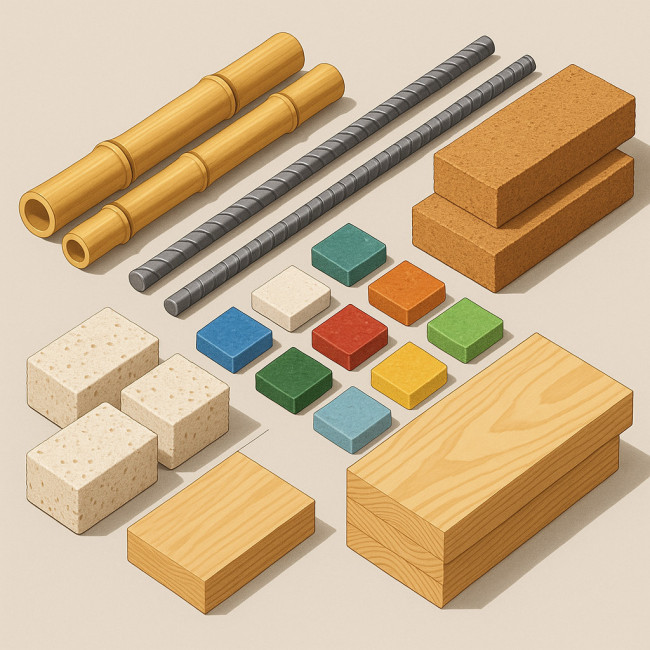Ethical sourcing: list sustainable materials to win eco-minded project leads
Looking to attract clients who prioritise low-impact construction and design? This guide lists the most convincing sustainable materials, shows you how to validate their origins, and shares pitch tips that transform ethical sourcing into a competitive advantage.
Why ethical sourcing wins more briefs
Eco-minded brands and public institutions increasingly demand transparent supply chains, reduced carbon footprints and fair labour practices. By proving your commitment to ethical sourcing you:
- Shorten decision cycles—procurement teams can tick sustainability boxes faster.
- Command premium rates—75 % of corporate buyers say they pay more for verified green materials.
- Unlock larger tenders that require environmental credentials by default.
- Differentiate your profile on platforms like Artfolio's spatial-design listings.
Top sustainable materials and how to pitch them

From quickly renewable bamboo stalks cut into structural beams to shimmering recycled glass tiles rescued from bottle banks, each featured material tells a climate-positive story that procurement officers love to hear. Imagine a sample box that reveals the honeycomb texture of mycelium boards beside cross-laminated timber layers, or the warmth of cork sheets adjacent to recycled steel offcuts that prove circularity in heavy industry. Use the accompanying visual to memorise key talking points before your next pitch—it condenses hundreds of life-cycle data points into one glance while reinforcing the notion that sustainable design can be both aesthetically compelling and structurally robust.
Below is a curated list of planet-friendly materials, their sourcing checkpoints and selling points that resonate with project leads.
| Material | Key Benefit | Sourcing Certification | Pitch Angle |
|---|---|---|---|
| Bamboo | Rapid renewability; grows up to 1 m/day. | FSC, LEED | “Stronger than steel in tension yet 50 % lighter—ideal for quick, low-carbon builds.” |
| Recycled steel | Reduces mining impact by 58 %. | SCS Recycled Content | “Same structural integrity, 75 % lower embodied energy.” |
| Cork | Harvested without felling trees; natural thermal and acoustic insulation. | PEFC, Amorim NDtech | “Turns walls into carbon sinks while trimming HVAC bills.” |
| Mycelium composites | 100 % biodegradable; grown from agricultural waste. | Cradle to Cradle Gold | “Custom-mould shapes in five days—zero petrochemicals.” |
| Recycled glass tiles | Uses post-consumer bottles; vibrant colour range. | GreenGuard Gold | “Story-rich surfaces: each square metre diverts 9 kg of waste.” |
| Cross-laminated timber (CLT) | Sequesters up to 1.4 tonnes CO₂/m³; high fire resistance. | FSC, Programme for the Endorsement of Forest Certification | “Prefabrication cuts on-site labour by 30 % and noise by 75 %.” |
Bamboo
Bamboo matures in 3–5 years versus 50 years for conventional timber. Specify species such as Phyllostachys edulis for balance between tensile strength and flexibility. Always request chain-of-custody documentation from growers and check phytosanitary certificates for cross-border shipments.
Recycled steel
Insist on mill certificates showing minimum 80 % recycled content. Match alloys to structural requirements and present comparative life-cycle analyses (LCA) to prove a smaller footprint than virgin steel.
Need advanced guidance? Our eco-certified metals breakdown walks you through supplier audits step-by-step.
Cork
Promote cork's naturally antimicrobial properties for hospitality or healthcare interiors. Show tree-ring stamps or QR codes that trace bark to specific Portuguese montados. This transparency reassures risk-averse clients.
Mycelium composites
Grown in low-energy incubators, mycelium can replace foams and even load-bearing bricks. Lab-grade density tests (e.g., ASTM D1621) validate structural performance. Pitch the material as part of a circular take-back programme to delight zero-waste reviewers.
Recycled glass
Use spectrographic reports to confirm lead-free formulations. Partner with community bottle-collection schemes to add social-impact points in tenders. The recycled glass sourcing playbook dives deeper into regional incentives.
Cross-laminated timber
CLT panels arrive CNC-cut, reducing site offcuts by up to 80 %. Emphasise rapid assembly and carbon sequestration in your proposals. Double-check fire-rating reports to pre-empt insurer queries.
Certification roadmap that impresses procurement teams
- Select recognised standards. Aim for ISO 14001 manufacturing sites and product-specific seals such as FSC or Cradle to Cradle.
- Audit suppliers annually. Request third-party site inspections and worker welfare documents to avoid green-washing risk.
- Create a digital evidence vault. Store certificates, LCA PDFs and material passports in one shareable folder. This accelerates compliance reviews.
- Publish a sourcing policy. A concise PDF outlining targets (e.g., 75 % recycled or renewable content by 2026) signals accountability.
For a full game plan, explore our sustainable sourcing plans template.
Implementation steps: from sample to site
- Prototype locally. Small-batch tests validate aesthetics and performance before committing to global freight emissions.
- Integrate digital twins. 3D models containing environmental data help engineers spot clashes and evaluate embodied carbon instantly.
- Train contractors. Run workshops on handling unfamiliar materials like mycelium or CLT to curb site delays.
- Monitor after installation. IoT sensors can track indoor air quality improvements when using zero-VOC finishes. See our eco-certified finishes guide for sensor specs.
Quick self-assessment quiz
FAQ
- Is ethical sourcing more expensive?
- Upfront unit prices can be 5–15 % higher, but lifecycle savings from durability, energy efficiency and brand value often outweigh the initial cost.
- How can I verify a supplier's labour practices?
- Request SA8000 or Fairtrade audits, interview workers during site visits, and check for third-party whistle-blower hotlines.
- Do recycled materials compromise quality?
- No. Standards such as SCS Recycled Content and strict ASTM tests ensure recycled steel and glass meet or surpass virgin equivalents.
- What if my client hasn't asked for sustainable options?
- Present a side-by-side impact analysis. Many decision-makers upgrade once they see carbon and cost data in plain numbers.
Take the next step
Your next brief could prioritise traceable, low-impact materials. Start today: audit one supplier, collect certifications, and update your portfolio highlights. Doing so positions you as the go-to expert for responsible design.
Ready to lead the change? Shortlist two ethical suppliers this week and add their materials to your sampling kit. Clients notice—projects follow.











